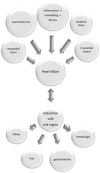The Diagnostic and Therapeutic Value of Multimarker Analysis in Heart Failure. An Approach to Biomarker-Targeted Therapy
- PMID: 33344515
- PMCID: PMC7746655
- DOI: 10.3389/fcvm.2020.579567
The Diagnostic and Therapeutic Value of Multimarker Analysis in Heart Failure. An Approach to Biomarker-Targeted Therapy
Abstract
Background: Heart failure is a pathophysiological state, which is still associated with high morbidity and mortality despite established therapies. Diverse well-known biomarkers fail to assess the variety of individual pathophysiology in the context of heart failure. Methods: An analysis of prospective, multimarker-specific therapeutic approaches to heart failure based on studies in current literature was performed. A total of 159 screened publications in the field of biomarkers in heart failure were hand-selected and found to be eligible for this study by a team of experts. Results: Established biomarkers of the inflammatory axis, matrix remodeling, fibrosis and oxidative stress axis, as well as potential therapeutic interventions were investigated. Interaction with end organs, such as cardio-hepatic, cardio-renal and cardio-gastrointestinal interactions show the complexity of the syndrome and could be of further therapeutic value. MicroRNAs are involved in a wide variety of physiologic and pathophysiologic processes in heart failure and could be useful in diagnostic as well as therapeutic setting. Conclusion: Based on our analysis by a biomarker-driven approach in heart failure therapy, patients could be treated more specifically in long term with a consideration of different aspects of heart failure. New studies evaluating a multimarker - based therapeutic approach could lead in a decrease in the morbidity and mortality of heart failure patients.
Keywords: biomarkers; cardiovascular medicine; heart failure; multimarker analysis; targeted therapy.
Copyright © 2020 Topf, Mirna, Ohnewein, Jirak, Kopp, Fejzic, Haslinger, Motloch, Hoppe, Berezin and Lichtenauer.
Conflict of interest statement
The authors declare that the research was conducted in the absence of any commercial or financial relationships that could be construed as a potential conflict of interest.
Figures





Similar articles
-
Novel Biomarkers of Heart Failure in Pediatrics.Children (Basel). 2022 May 18;9(5):740. doi: 10.3390/children9050740. Children (Basel). 2022. PMID: 35626917 Free PMC article. Review.
-
Multimarker testing with ST2 in chronic heart failure.Am J Cardiol. 2015 Apr 2;115(7 Suppl):76B-80B. doi: 10.1016/j.amjcard.2015.01.045. Epub 2015 Jan 23. Am J Cardiol. 2015. PMID: 25697916 Review.
-
A multimarker multi-time point-based risk stratification strategy in acute heart failure: results from the RELAX-AHF trial.Eur J Heart Fail. 2017 Aug;19(8):1001-1010. doi: 10.1002/ejhf.749. Epub 2017 Jan 30. Eur J Heart Fail. 2017. PMID: 28133908 Clinical Trial.
-
Multimarker approach in cardiovascular risk prediction.Dis Markers. 2009;26(5-6):273-85. doi: 10.3233/DMA-2009-0633. Dis Markers. 2009. PMID: 19773616 Free PMC article. Review.
-
Multimarker approach for heart failure management: perspectives and limitations.Pharmacol Res. 2011 Jul;64(1):11-24. doi: 10.1016/j.phrs.2011.03.006. Epub 2011 Apr 2. Pharmacol Res. 2011. PMID: 21440629 Review.
Cited by
-
Predictive value of serum irisin for chronic heart failure in patients with type 2 diabetes mellitus.Mol Biomed. 2022 Nov 9;3(1):34. doi: 10.1186/s43556-022-00096-x. Mol Biomed. 2022. PMID: 36350412 Free PMC article.
-
Analysis of Selected Cardiovascular Biomarkers in Takotsubo Cardiomyopathy and the Most Frequent Cardiomyopathies.Front Cardiovasc Med. 2021 Nov 3;8:700169. doi: 10.3389/fcvm.2021.700169. eCollection 2021. Front Cardiovasc Med. 2021. PMID: 34805296 Free PMC article.
-
The differential diagnostic value of selected cardiovascular biomarkers in Takotsubo syndrome.Clin Res Cardiol. 2022 Feb;111(2):197-206. doi: 10.1007/s00392-021-01956-2. Epub 2021 Nov 2. Clin Res Cardiol. 2022. PMID: 34727211 Free PMC article.
-
Differential Diagnosis between Takotsubo Syndrome and Acute Coronary Syndrome-A Prospective Analysis of Novel Cardiovascular Biomarkers for a More Selective Triage.J Clin Med. 2022 May 25;11(11):2974. doi: 10.3390/jcm11112974. J Clin Med. 2022. PMID: 35683362 Free PMC article.
-
Evaluation of new and old biomarkers in dogs with degenerative mitral valve disease.BMC Vet Res. 2022 Jul 2;18(1):256. doi: 10.1186/s12917-022-03343-z. BMC Vet Res. 2022. PMID: 35780161 Free PMC article.
References
-
- Ponikowski P, Voors A, Anker S, Bueno H, Cleland JGF, Coats AJS, et al. ESC Guidelines for the diagnosis and treatment of acute and chronic heart failure: the Task Force for the diagnosis and treatment of acute and chronic heart failure of the European Society of Cardiology (ESC). Developed with the special contribution of the Heart Failure Association (HFA) of the ESC. Eur Heart J. (2016) 37:2129–200. 10.1093/eurheartj/ehw128 - DOI - PubMed
Publication types
LinkOut - more resources
Full Text Sources

